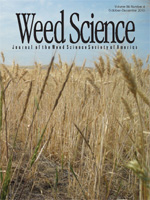Field studies examined the interaction of soil pH with differing levels of atrazine exposure over 4 yr. Soil pH was 5.2 to 7.1 with atrazine exposures ranging from none (0) to eight applications over a 4-yr period (for each year, one application at planting and one early postemergence). The entire plot area was uniformly managed to reduce potential confounding effects due to cropping history, tillage, and other factors. Soil from all plots previously treated with atrazine displayed rapid atrazine dissipation, with half-lives under laboratory conditions being less than 4 d in plots of pH 5.5 or greater and less than 8 d in the field. Soil pH had a marked effect, with slower atrazine dissipation in those plots that had a pH 5.5 or less. This effect of pH and previous atrazine history was consistent in laboratory and field environments. Implications of these findings include probable reduction in weed control due to more rapid atrazine dissipation and potentially reduced loadings into surface water due to this phenomenon.
Nomenclature: Atrazine.





